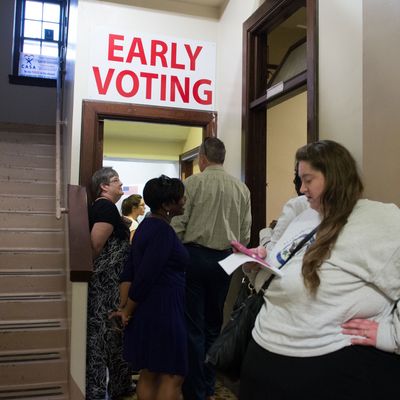
Every election year, as a matter of habit and convenience, we all talk about “Election Day” as though it is a defined nationwide event. But the reality is far more complex thanks to the advent of widespread no-excuse-required voting prior to Election Day by mail or in person. Indeed, as Patrick Healy of the New York Times reminds us today, nearly a third of the ballots counted in the last presidential general election were cast before Election Day — a figure that regularly rises as states follow a trend toward less traditional voting practices.
It is difficult to generalize about early-voting practices, unfortunately, because the 50 states have wildly varying laws and procedures. Some of these, such as the dates for beginning to mail out absentee ballots — effectively the beginning of “Election Day” — are for the most part informal. Others reflect very different local decisions about balloting procedures, ranging from the three all-mail-ballot states (Colorado, Oregon, and Washington) to states (including most northeastern states and several in the South) that have no early in-person voting and only allow absentee ballots for specified reasons (e.g., Election Day travel).
But for the 37 states that do provide for some kind of early voting, campaigns need to be acutely aware that the chance to reach some voters ends not on “Election Day” but when they happen to fill out mail or absentee ballots or take advantage of in-person early-voting opportunities. And as Healy points out, that’s where Hillary Clinton’s undisputed organizational advantage over Donald Trump could begin to become crucial earlier rather than later — as early as September 23, when early voting begins in Minnesota and South Dakota.
Indeed, Team Clinton is building on the 2008–12 Obama campaign’s highly sophisticated system for “banking” early votes in some competitive states and then shifting resources to states that are closer or that have fewer early voters. In line with its candidate’s relative indifference to field operations beyond his own ability to mobilize voters via personal appearances, Team Trump is a long way from having anything like that capacity. So as the Electoral College battleground begins to narrow going into the home stretch in early October (early voting begins in Ohio on October 12), the Trump campaign may well be bringing a knife to a gun fight as it deploys resources and candidate time promiscuously or as dictated by instinct or broad-based polling.
It’s worth noting that part of the early-voting landscape is still in flux in a few states (North Carolina, Wisconsin, and Texas) where Republican efforts to restrict in-person early voting (a practice that African-American voters disproportionately take advantage of) are being held up in the courts, along with voter-ID requirements and other measures aimed at constituencies that tend to vote Democratic. But in most states the two parties know what they will be dealing with as voting decisions approach. And it seems likely that Democrats will maintain their recent advantage in this area.
In practice, that means that the time Trump has to catch up with Clinton’s recent surge in national and state polls is not as long as it might initially seem. It’s true that most early votes will be cast after the first (September 26) and second (October 9) presidential debates. If the often-incoherent Trump has some sort of debate breakthrough (unlikely but possible), that will affect early voters as much as or more than the early TV advertising Clinton and her allies are already undertaking. But as with any strategic consideration, counting on any one factor to produce victory is risky, particularly for a candidate with as many handicaps as Donald Trump. And time’s a-wasting.






























